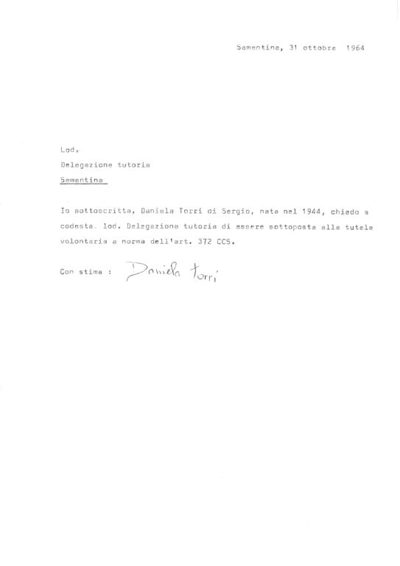Involuntary «voluntary guardianship»
 Archivio del Comune di Sementina: Incarto personale della Delegazione Tutoria, Daniela Torri, 1964, «Tutela volontaria»
Archivio del Comune di Sementina: Incarto personale della Delegazione Tutoria, Daniela Torri, 1964, «Tutela volontaria» The archive document dated 31 October 1964 confirms that, after attaining the age of majority and upon termination of her administrative detention in the Cantonal Neuropsychiatric Hospital (CNH) of Mendrisio, Daniella Schmidt (née Torri) filed a request with the Guardianship Commission (GC) of the municipality of Sementina to be placed under «voluntary guardianship». The interview conducted by the IEC with Schmidt in 2017 provides a different perspective on the events: the municipal authority had deceived the young woman as to the dramatic consequences her consent to voluntary guardianship would have.
Source content
Schmidt was born to unmarried parents on 13 June 1944. She was abandoned at birth by her parents and placed under guardianship as an «illegitimate minor». After having first been placed in a series of different foster institutions, she was ultimately put in administrative detention at the CNH from 1960 to 1964. She was released two days after attaining the age of majority, at which time the guardianship measure for «illegitimate minors» ceased to apply. At first glance, the source would appear to be unambiguous: it is a letter dated 31 October 1964, signed by Schmidt, in which the newly of age young woman requests the GC of Sementina place her under «voluntary adult guardianship».
Source context
Other GC documents attest to the fact that there had been frequent communication, both by telephone and by correspondence, between the GC and the Guardianship Protection Authority (GPA). The two authorities had expressly determined that the young woman in question, despite having been released from the CNH and having attained majority, should not be granted complete freedom. They had agreed between them that the best means of ensuring that she remained subject their authority would be to have her sign a request for voluntary guardianship. The agreement between the municipal and cantonal authorities calls into question the voluntary nature of the request signed by Daniella Schmidt.
Interview: an oral history source provides a new perspective
At the 2017 interview, asked about the document she had signed in 1964, Schmidt replied: «Yes, I read it, but I it was complete gibberish to me». If she had fully understood the consequences, she added, «I would never have signed such a thing!» Claiming that they had deceived her, she addressed herself directly to the GC and GPA: «Yes, you did a real job on me. A good one. You’re a bunch of swindlers and conmen!» And repeating her claim: «As far as I’m concerned, it was a con job.»
Methodological remarks
One of the objectives of the IEC is to bring to light the way in which administrative detention was experienced by the detainees themselves. The usefulness of archival documents is severely limited in this respect as, for the most part, they express only the standpoint of those responsible for ordering administrative detention measures. To overcome this limitation, it is necessary to submit such sources to a critical analysis – carefully examining all the relevant documentation available and taking into account the historical context in which they were embedded. In some instances, however, this may be difficult or even impossible, or simply insufficient. This being the case, the direct testimony of individuals who were themselves subjected to coercive measures thus takes on a fundamental role. The interviews conducted with Schmidt are important sources of oral history and are of particular relevance within the historical and sociological approach adopted by the ICC. They provide valuable supplementary information that makes it possible for us to contextualize the archival documents analysed and consider them from a different perspective. The simultaneous availability of written and oral sources, even if they stem from different periods of time, is a major advantage for scholarly research and deserves the development of integrative methods of analysis and of diversified research questions.
M. Nardone/Translation
Remarks
The story of Daniella Schmidt’s life is recounted by M. Nardone in IEC volume 1: Gesichter der administrativen Versorgung (pp. 190-199).
Sources
Archivio del Comune di Sementina, Incarto personale della Delegazione Tutoria, Daniela Torri, 1964.
Excerpt from the interview transcript IEC 2017, D. S., pp. 19-20.
 next source
next source


